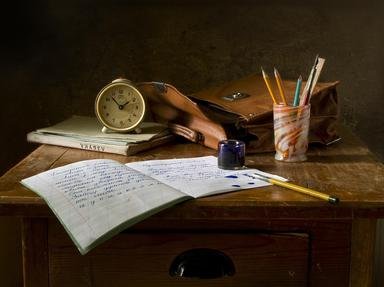Quiz Answer Key and Fun Facts
1. "What's Bred in the Bone", the story of Francis Cornish, is the second book in Robertson Davies' "Cornish Trilogy". What was Francis Cornish's role in the first book, "The Rebel Angels"?
2. "What's Bred in the Bone" begins with an announcement of failure. Professor the Reverend Simon Darcourt, an old friend of Francis Cornish, dejectedly explains to Cornish's nephew and niece-in-law that he cannot complete his task. What has Darcourt been trying to do?
3. The meat of the novel is the life of Francis Cornish, as recalled by a pair of lesser supernatural beings -- the Angel of Biography and the Daimon who helped Francis make something of his life. Being supernatural, they can begin at the very beginning. Which of these is the best description of the match between Francis's parents, the staid Francis "Wooden Soldier" Cornish and the beautiful Mary-Jacobine McRory?
4. After the untimely death and burial of the eldest child, our own Francis -- Francis the Second -- is born. He is an unhappy child, ignored by his parents, and he finds refuge in drawing. After learning the basics from a book on caricature, how does Francis hone his skills?
5. In his vast house and quietly unhappy family, Francis grows up in the shadow of secrets, and the deepest and worst of these is in the attic just above his own rooms. What does Francis find up there as a boy?
6. Years pass. Francis leaves his hometown of Blairlogie for Toronto, and then for Oxford to pursue a graduate degree. It's at Oxford that he meets his cousin Ismay, with whom he goes on to share a failed and lingering marriage. What dooms their union from the start?
7. Art is Francis's passion, and most especially the art of the Old Masters; spying is his vocation, passed on from his father and nurtured by "Uncle Jack" in London. When the two callings meet in the late 1930s, and Uncle Jack asks him to apprentice himself to the great art restorer Tancred Saraceni for a project in Germany, Francis jumps at the chance. What is Saraceni really doing at Düsterstein Castle?
8. As part of Francis's apprenticeship with Saraceni, he travels from Düsterstein to prove that a newly discovered painting -- a Harrowing of Hell, supposedly by Hubertus van Eyck -- is a fake. No chemical or radiological tests are permitted by the owner, and the work is exquisite. How does Francis prove the picture is a fake?
9. After the war, Francis serves on a panel of experts trying to bring order and justice to the vast Nazi caches of stolen, borrowed, and misappropriated art. This task, never easy, becomes more difficult when the panel ends up discussing one of Francis's own paintings from his time at Düsterstein. What name does the panel end up assigning the artist responsible for "The Marriage at Cana"?
10. After another decade or so in MI-5, Francis returns to Canada for the beginning of the rest of his life. How does he spend the time that remains to him?
Source: Author
CellarDoor
This quiz was reviewed by FunTrivia editor
LadyCaitriona before going online.
Any errors found in FunTrivia content are routinely corrected through our feedback system.
